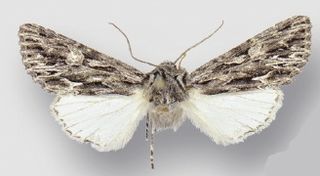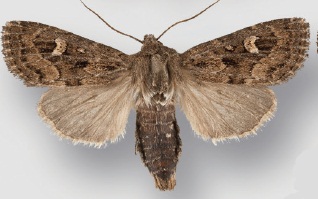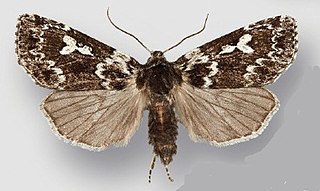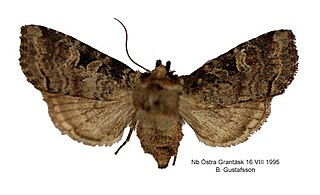| Mesogona | |
|---|---|
 | |
| Mesogona oxalina | |
| Scientific classification | |
| Domain: | Eukaryota |
| Kingdom: | Animalia |
| Phylum: | Arthropoda |
| Class: | Insecta |
| Order: | Lepidoptera |
| Superfamily: | Noctuoidea |
| Family: | Noctuidae |
| Subfamily: | Noctuinae |
| Genus: | Mesogona Boisduval, 1840 |
| Mesogona | |
|---|---|
 | |
| Mesogona oxalina | |
| Scientific classification | |
| Domain: | Eukaryota |
| Kingdom: | Animalia |
| Phylum: | Arthropoda |
| Class: | Insecta |
| Order: | Lepidoptera |
| Superfamily: | Noctuoidea |
| Family: | Noctuidae |
| Subfamily: | Noctuinae |
| Genus: | Mesogona Boisduval, 1840 |

Cycnia is a genus of tiger moths in the family Erebidae. The genus was erected by Jacob Hübner in 1818.

Cerastis is a genus of moths of the family Noctuidae.

Drasteria is a genus of moths in the family Erebidae.

Fishia is a genus of moths of the family Noctuidae.
Lasionycta is a genus of moths of the family Noctuidae.

Resapamea is a genus of moths of the family Noctuidae.

Xestia perquiritata, the boomerang dart, is a moth of the family Noctuidae. The species was first described by Herbert Knowles Morrison in 1874. It is found across North America from Newfoundland, Labrador and northern New England, west to central Yukon, British Columbia and Washington. There are several disjunct populations, including one in the Great Smoky Mountains National Park and the Rocky Mountains in Colorado and a coastal bog in central Oregon.

Resapamea mammuthus is a moth in the family Noctuidae. It only known only from the type locality at Old Crow, Yukon Territory.
Hydraecia intermedia is a moth in the family Noctuidae first described by William Barnes and Foster Hendrickson Benjamin in 1924. It is only known from the holotype, with the type locality of Fort Calgary in south-western Alberta, Canada.
Xestia laxa is a species of cutworm or dart moth in the family Noctuidae. It was described by J. Donald Lafontaine and Kauri Mikkola in 1998 and is found in North America.

Hillia iris, the iris rover, is a species of cutworm or dart moth in the family Noctuidae. It was described by Johan Wilhelm Zetterstedt in 1839 and is found in North America.

Coxina cinctipalpis, the black-waved owlet, is a species of moth in the family Erebidae. It was described by Smith in 1899 and is found in Mexico and the southern United States.
Chaetaglaea fergusoni, or Ferguson's sallow moth, is a moth in the family Noctuidae. It was described by Vernon Antoine Brou Jr. in 1997 and is found in North America.
Homorthodes dubia is a species of cutworm or dart moth in the family Noctuidae. It was described by William Barnes and James Halliday McDunnough in 1912 and is found in North America.

Tesagrotis corrodera is a species of cutworm or dart moth in the family Noctuidae. It was described by Smith in 1907 and is found in North America.

Lithophane grotei, commonly known as Grote's pinion or Grote's sallow, is a species of moth in the family Noctuidae. It was first described by Riley in 1882 and it is found in North America.
Brachylomia sierra is a moth in the family Noctuidae, native to North America. The species was first described by James T. Troubridge and J. Donald Lafontaine in 2007.
Neleucania patricia is a species of cutworm or dart moth in the family Noctuidae. It is found in North America.

Lacinipolia triplehorni is a species of cutworm in the family Noctuidae. It is found in North America.

Tricholita chipeta is a species of cutworm or dart moth in the family Noctuidae. It was first described by William Barnes in 1904 and it is found in North America.